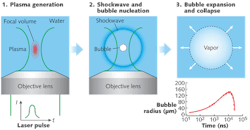PULSED-LASER-INDUCED CAVITATION: Ultrafast bubbles enable novel nano/microfluidic systems
Various fluid delivery and actuation mechanisms on the micro- and nanoscale have been devised using both optical and mechanical methods; now, researchers at the University of California at Los Angeles (UCLA) have demonstrated multiple novel fluidic devices based upon the high speeds, high pressures, and strong forces created by pulsed-laser-driven cavitation bubbles.1 A high-speed microfluidic switch, a fluorescence-activated cell sorter, and a high-speed droplet-on-demand device are just three of the technologies enabled by this laser-induced effect.
When a laser pulse is highly focused in a liquid medium, the laser energy breaks down the molecules in the liquid and generates ionized hot plasma (6000-15,000 K) near the focal point (see figure). On nanosecond time scales, the hot plasma recombines, instantly heats the liquid, and creates an explosive vapor bubble that expands at a speed greater than 100 m/s. Pressure inside the bubble can be as high as tens of megapascals. Triggering these bubbles takes nanoseconds or even femtoseconds depending on the pulse duration.
Putting the bubbles to work
The first of three devices demonstrated by the UCLA researchers is a laser-triggered microfluidic switch. A Q-switched, frequency-doubled 532 nm, 108 μJ Nd:YAG laser with a pulse duration of 6 ns is focused in the middle of a 50 μm wide microfluidic channel that is just adjacent to the lower arm of the Y-junction of another microfluidic channel. Particles traverse the main channel in a stream and are deflected to the lower arm of the Y-junction by its design. When a cavitation bubble is formed by the laser in the adjacent microfluidic channel, the bubble expands and forces the lower channel wall (composed of a flexible material) to narrow, diverting particles to the upper channel of the Y-junction. Rapid switching (on the order of microseconds in this case) based on deformation and restoration of the channel wall is achieved, and can be customized based on the microfluidic channel material properties and the pulse attributes of the laser used.
The second device, a fluorescence-activated cell sorter, uses a Q-switched Nd:YVO4 laser focused in a microfluidic channel to "push" fluorescent particles (or cells) into a particular channel for sorting. Particles that do not fluoresce when illuminated by a second 488 nm laser are directed into the waste channel at a Y-junction. But when a particle fluoresces, the Nd:YVO4 laser is activated and creates a vapor bubble within the microfluidic channel that pushes the fluorescent particle in the non-waste arm of the Y-junction for analysis.
And finally, a third device generates liquid droplets on demand. Unlike most microfluidic devices that sort or manage the flow of particles within a continuous liquid medium, droplet-based microfluidic devices contain those particles (one or many) in a smaller volume of fluid within an oil medium, effectively separating the droplets without cross-contamination and within a (hopefully) uniform volume. For this device, a laser is focused at a water/oil interface within a nozzle-shaped opening. The rapid bubble expansion induced by a laser pulse pushes a small amount of water into the oil channel. As the bubble collapses, hydrodynamic forces create a droplet of water within the oil medium at a speed controlled by the laser pulse rate. On-demand generation of as many as 10,000 droplets per second has been achieved—faster (and with higher volume uniformity) than other active (control-valve based) or even passive devices.
"Laser pulse-induced bubble cavitation is a new microfluid and nanofluid actuation mechanism," says Eric P.Y. Chiou, an assistant professor in the Mechanical and Aerospace Engineering Department at UCLA. "It provides high energy density, fast energy conversion, highly localized, and large mechanical forces for high-speed microfluid actuation in a highly damped environment. The energy is delivered through free-space optical propagation and does not require any physical electrical or mechanical interconnects, which greatly reduces the complexity of device fabrication. It has the potential for parallel actuation by integrating optical scanners and lenses."
REFERENCE
1. P.-Y. Chiou et al., SPIE Optics + Photonics 2010 Conf., paper 7759-36, San Diego, CA (Aug. 3, 2010).

Gail Overton | Senior Editor (2004-2020)
Gail has more than 30 years of engineering, marketing, product management, and editorial experience in the photonics and optical communications industry. Before joining the staff at Laser Focus World in 2004, she held many product management and product marketing roles in the fiber-optics industry, most notably at Hughes (El Segundo, CA), GTE Labs (Waltham, MA), Corning (Corning, NY), Photon Kinetics (Beaverton, OR), and Newport Corporation (Irvine, CA). During her marketing career, Gail published articles in WDM Solutions and Sensors magazine and traveled internationally to conduct product and sales training. Gail received her BS degree in physics, with an emphasis in optics, from San Diego State University in San Diego, CA in May 1986.
